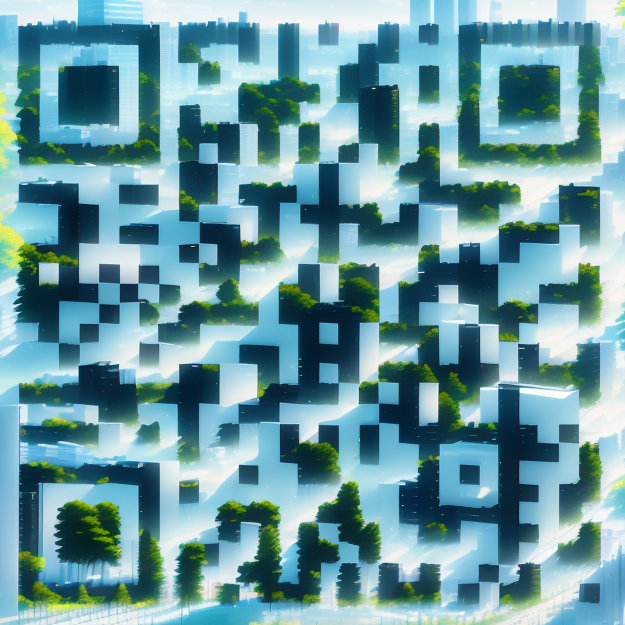来自ASLA对gooood的分享。
Miridae Mobile Nursery: Growing a Native Plant Community | Miridae
项目概述
PROJECT STATEMENT
通过将植物、科学家和景观设计师带入社区,移动苗圃能够促进加州本土植物的培育并帮助它们扎根。该项目的使命是鼓励人们在自己的花园和社区种植对环境有益的本土植物。这些城市地区和郊区为缓解气候变化、建立鸟类和授粉生物栖息地提供了有利的机会,使多样化的社区能够更频繁地接近大自然,同时也帮助居民有效地将本土植物纳入他们的花园。随着移动苗圃在萨克拉门托地区的发展,该行动的影响力已从个人逐渐扩散至社区和城市。
移动苗圃行动始于2020年的疫情高峰期,它以一辆经过改装的箱式卡车为载体,能够在安全社交距离下将人们聚集在一起。车辆由居民驾驶,并招募他们的邻居参与,共同创造社区环境,鼓励与生态学家和设计师进行对话。社区的规模使项目团队能够针对特定场地来提供定制的方案并给出种植本土植物的建议——这在大多数零售场景下是难以达到的。
The Mobile Nursery elevates California native plants and encourages them to take root by bringing plants, scientists, and landscape architects into communities. Its mission is to encourage people to plant environmentally-beneficial native plants in their gardens and communities. These urban and suburban areas are powerful opportunities to mitigate climate change, build bird and pollinator habitat, provide access to nature to a diversity of communities, and empower people to effectively incorporate native plants into their gardens. The impact begins with the individual and scales up to the neighborhood and the city, as the Mobile Nursery makes its way through the Sacramento Region.
Launched in 2020 at the height of the Covid-19 pandemic, the Mobile Nursery, a retrofitted box truck, was designed to bring people together in a safe and socially-distanced way. Residents host the truck and recruit their neighbors to attend, creating a community environment and encouraging conversations with the ecologists and designers staffing the truck. The neighborhood scale allows our team to offer custom, location-specific advice and locally-grown plant species unavailable at most retail locations.
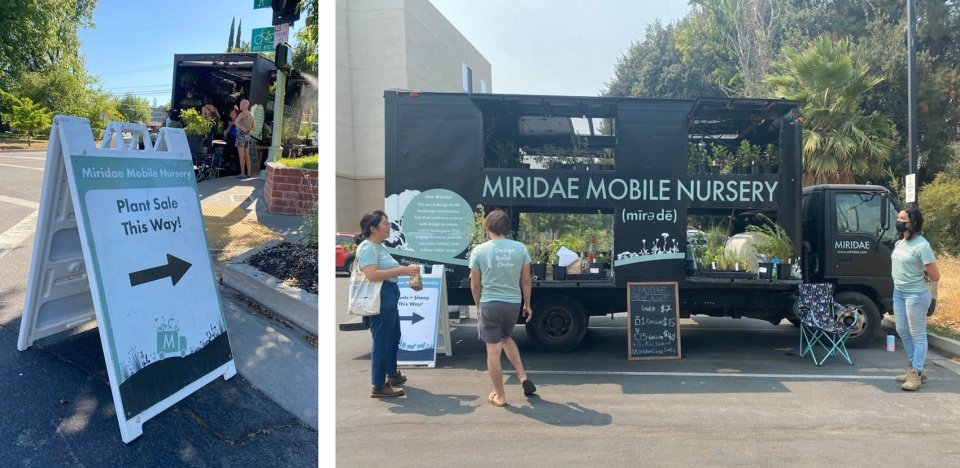
▲购买本地植物请走这里!移动苗圃的创建是为了在社区范围内培养本土景观,使这些植物更容易获得,同时传达在社区内建立成片生境的重要性。Native Plant Sale This Way! The Mobile Nursery was created to foster native landscapes at the scale of the neighborhood, to make these plants more accessible, and to communicate the importance of building a patchwork of habitat across our neighborhoods. ©Miridae
项目说明
PROJECT NARRATIVE
设计:从卡车到苗圃
移动苗圃的创建是为了在社区范围内培养本土景观,使这些植物更容易被不同的人群接受,同时也是为了宣传在社区内建立类似生境的重要性。 长期以来,Miridae一直致力于通过设计和建造项目来为亲手种植花园、或因预算紧张而无法实现花园整体翻修的人群提供支持。项目团队很早就意识到他们是改变周围建筑环境的一股重要力量。如何才能帮助他们成功地种植本地植物,同时为萨克拉门托地区的野生动物提供帮助?如何在预算并不充裕的情况下组织大量居民,将他们每个人的花园汇聚成一片大面积的栖息地?如何才能让园丁们成为公民科学家,使其有能力创造以数据为支撑的最佳实践,从而塑造可持续景观设计行业的未来?将野生动物栖息地通过设计转变为人类主导的空间,在这个方面,社区规模的园艺工作一直是被遗漏的关键一环。
“移动苗圃”是一辆被涂鸦覆盖的、用于运送产品的箱式卡车,它购买于2020年2月。项目团队希望这辆卡车能够同时具备功能性和互动性,并且可以折叠为一个零售空间,包含售卖植物的桌子、遮阳蓬,以及为炎热夏季降温的水雾器。为了让植物保持茁壮生长,需要足够的空气、阳光、水和太阳能来运行卡车内的苗圃系统。在与设计和建造团队的合作下,卡车的改造进行了反复修改,最终得出了一个简单而实用的方案:卡车的每一侧均设有两张折叠的桌面和两个顶篷。桌子为周围的人们留出了行走的空间,顶篷则在提供阴凉的同时作为展示车内其他植物的窗口。此外,车上还增加了一个类似于冰淇淋车的“响铃”装置,旨在吸引邻居们的注意。铃声的设计受到了植物和昆虫的启发,包含来自当地各种野生动物的自然声响,如树蟋蟀、金雀的叫声、羽扇豆种子的爆裂声,甚至还有帝王蝶幼虫的咀嚼声。
以本地植物构建社区
移动苗圃于2020年5月正式启动,当时全世界都处于封锁状态,人们对Covid-19大流行病充满了焦虑。许多人渴望到户外去接触自然、种树养花,但又对大卖场的环境有所顾虑。正是在这样一种契机下,项目团队试图通过移动苗圃来将人们聚集在一起,并为苗圃的运作开发了一套有效、高效且安全的方法。
为了给这项行动赋予可持续性,项目团队雇用了加州大学戴维斯分校景观设计学和生态学的博士生,并为居民创建了一个“主持人工具包”(Host Toolkit),用来招揽邻居并促进移动苗圃的访问。整个过程不收取费用,也不要求最低人数,一切只靠人们的善意和自发的力量。主持人工具包涵盖电子邮件、社交媒体和传单模板,使宣传工作变得简单而有效。根据多个主持人的反馈,移动苗圃以一种全新的方法将他们与社区联系在一起——人们认识了之前从未见过的邻居,发现了彼此不知道的共同点,并通过销售植物的机会让大家以安全的方式聚集在一起。
在疫情持续期间,项目团队开始与餐厅和啤酒厂合作以进行交叉推广,鼓励人们参与户外活动。在萨克拉门托地区,除了个人、社区花园和社区内的农贸市场,还有一些固定的餐厅和酒馆作为移动苗圃的举办者。项目团队为其中一些企业提供了支持,将它们指定为预先订购的植物的取货点,如此一来也能吸引一些客人的消费。虽然加州已经取消了口罩和社交距离的相关规定,但这层支持关系仍在继续。
移动苗圃几乎每个周末都会被预定,从萨克拉门托城市网络中的社区,到富人区和工薪阶级所在的郊区,其受众涵盖了来自各种背景、种族和政治立场的居民。人们希望可以安全地获得植物,而集体的努力则促进了邻里之间的团结。
移动苗圃也被尝试用于更正式的社区参与和设计活动。它就像是磁铁一般,吸引着人们来到活动现场,同时也作为一种教学工具,向人们解释为什么某些特定的设计元素——如加州原生草地、树篱和授粉者花园——是设计提案中不可或缺的元素。移动苗圃通过参与、科普和提供接触本土植物的机会来创造社区的认同感。
经营移动苗圃的学生对传播本土植物的信息以及促进整个地区的使用展现出了极大的热情。由于植物的购买者都居住在本地社区,项目团队可以方便地为他们提供建议,告诉他们在哪些地方种植哪些植物,并根据不同场地给出有关浇灌和和观察野生动物的提示。此外,团队还积极向居民宣传本地植物的益处,鼓励他们选择种植本土植物。
下一步:培养公民科学家+研究
移动苗圃创造了一批新的公民科学家,并激发了一系列研究问题。景观设计团队和施工团队与非营利组织进行了配对,正在积极地承担设计和改造工作,并思考着当下已有的实践。例如,如果售出的植物结了种子,这些种子会不会在城市/郊区环境中发芽?种子会去往何处?去到多远?这些问题也引发了一个名为“种子堆”的项目(Seed Pile Project)。在该项目中,参与者(即公民科学家)被要求在城市、郊区和人行道旁放置一小堆本地种子,利用GPS对其定位,然后对植物发芽和生长的位置进行监测。其目标是观察、追踪和收集数据,以了解哪些物种(如有),以及它们在何种环境和管理条件下,能够成功地自行播种。这是一个从移动苗圃的日常运作以及邻居之间的交谈中生根发芽的公民科学项目。如结果理想,它将使设计者了解到人行道附近应当种植哪些物种,并向城市规划者提出针对公路和自行车道的种植建议。
移动苗圃还促使我们更仔细地观察社区范围内的影响:相比于在大型项目中种植数百株植物,向个人出售几株本地植物会有什么不一样?或者说,在一个花园里种植100株植物,和在10个花园里种植10株植物相比,会产生更好还是更差的生态效益?项目团队正在试图扭转SLOSS(Single Large or Several Small)的经典讨论,并尝试在较小的社区范围内对该理论进行研究。在考虑如何优化资源投资以保护环境时,SLOSS讨论通常被应用于大型空间,如海洋保护区,而不是像移动苗圃所涉及的这种小型空间,如城市花园和社区等。
移动苗圃有着简单的使命和商业模式:其使命是让本地植物进入社区,鼓励人们参与其中;其商业模式是,提供有趣的体验,并且必须自负盈亏。销售植物产生的所有利润都被直接用于公司下属的非盈利组织,后者的目标是将本地昆虫和植物作为各种研讨会的研究对象,并使STEM教育更加普及。移动苗圃正在不断地发展和成长为研究和设计项目——它们大部分集中在经常被忽视的日常居住领域和社区尺度内。
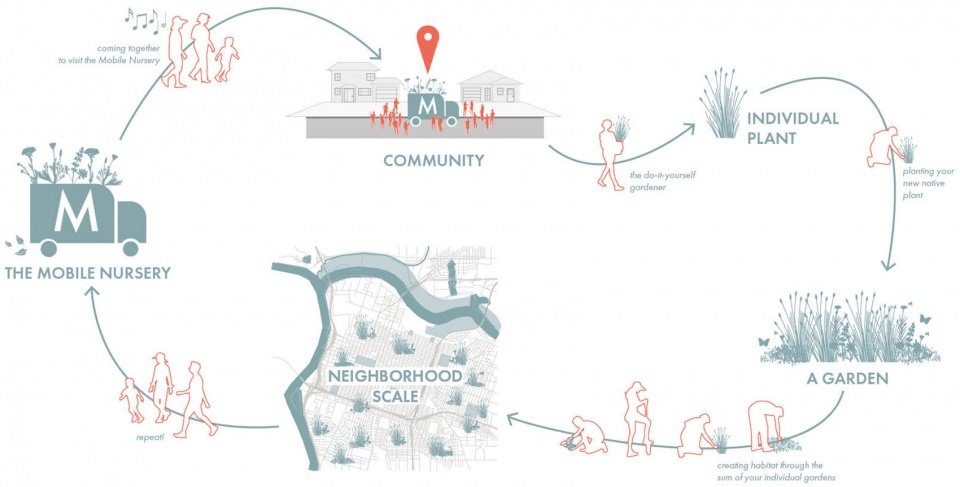
▲设计概念:移动苗圃从一个社区转向另一个社区。将野生动物栖息地通过设计转变为人类主导的空间,在这个方面,社区规模的园艺工作一直是被遗漏的关键一环。自主进行种植工作的园艺师将成改变我们建筑环境的重要力量。The Concept. Traveling neighborhood to neighborhood, the Mobile Nursery recognizes this scale as a crucial missing piece in the puzzle to designing wildlife habitat into human-dominated spaces, and sees do-it-yourself gardeners as important agents of change for our built environment.©Miridae
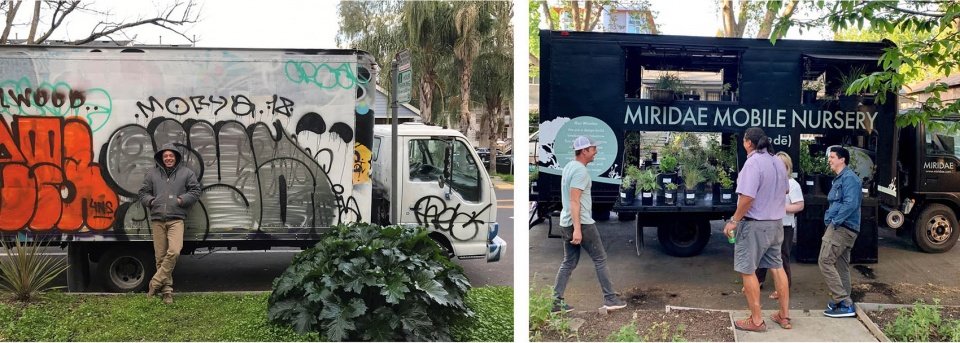
▲改造:移动苗圃是基于一辆农产品运输车而塑造的,它被改造成一个具有功能性和互动性的折叠式零售空间,包括用于售卖植物的桌子和遮阳顶棚。The Transformation. The Mobile Nursery began as a graffiti-covered produce delivery box truck and was transformed into a functional and interactive fold-out retail space, with tables to sell plants on and overhangs for shade.© Miridae
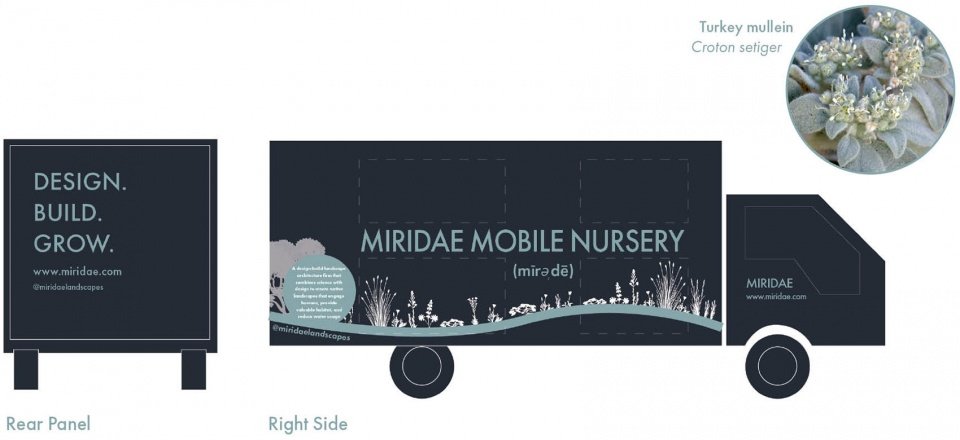
▲苗圃模型:设计团队和建造团队共同对卡车的改造方案和布局进行了反复修改,并与当地的一家招牌制作商合作设计了覆盖卡车的图案,并选用了代表公司的“土耳其毛蕊花”的独特色彩。The Mock-Up. Working with our design and build teams, we iterated layouts for the truck’s modifications and worked with a local sign shop to wrap the truck with silhouette images of native plants in the company’s unique “turkey mullein” color.© Miridae and CalPhotos at University of California, Berkeley

▲设计特点:移动苗圃的设计简单而实用,设有折叠式桌子和窗户、架子、通风和采光顶棚、水箱、用于夏季降温的水雾器,以及一个用于烘托氛围的特制“响铃”装置。Fabricated Features. The final design is simple and functional, with fold-out tables and windows, shelves, an open roof for sun and air, a water tank, misters to combat Sacramento’s hot summers, and a custom “jingle” to lighten the mood.© Miridae
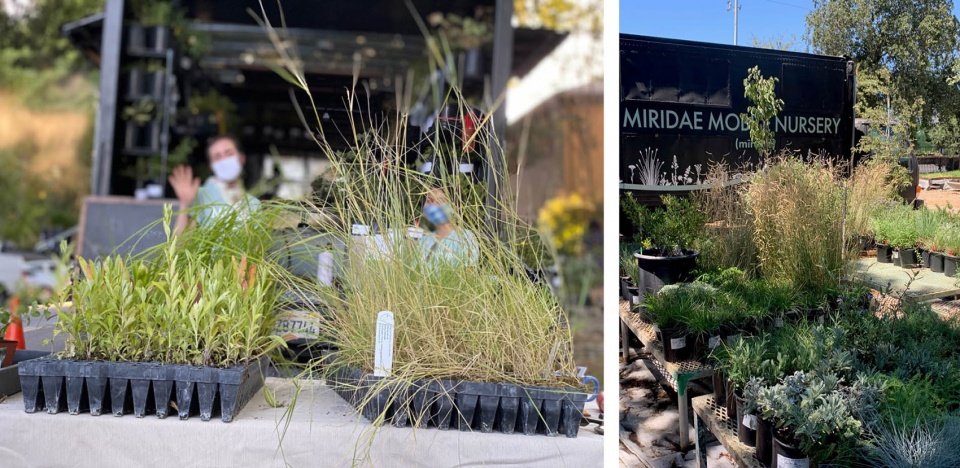
▲支持当地的种植者:移动苗圃的大部分库存来自矢车菊农场,这是一家当地的本土植物批发苗圃。它致力于为当地的种植者提供支持,并使他们更容易获得平时难以在市面上找到的加州本地植物。Supporting Local Growers. The majority of the Mobile Nursery’s inventory comes from Cornflower Farms, a local wholesale native plants nursery. It supports these local growers and makes California native plants, not typically found at retail locations, more readily available.© Miridae
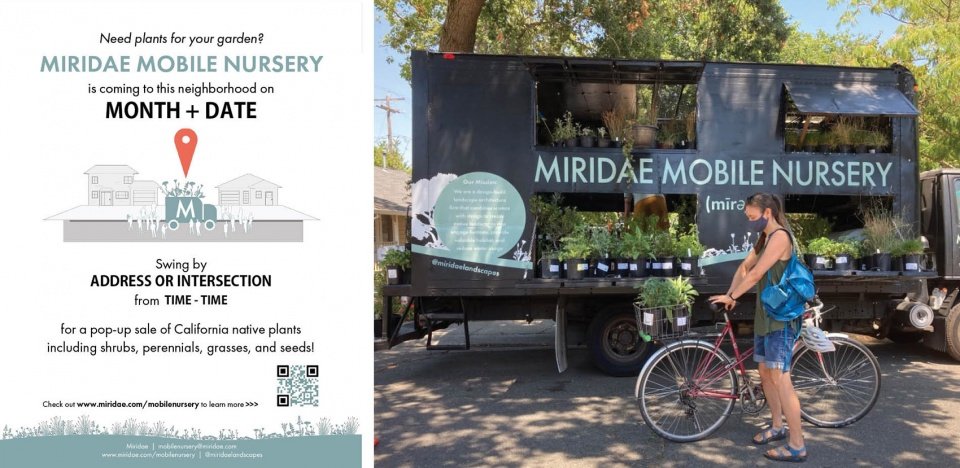
▲主持人工具包:主持人使用该工具包来招募社区成员参加移动苗圃计划,并助力其成为一项自负盈亏的业务。该工具包涵盖电子邮件、社交媒体和传单模板,使宣传工作变得简单而有效。The Host Toolkit. Hosts use the toolkit to recruit community members to their Mobile Nursery event, making this a self-sustaining operation. The toolkit includes email, social media, and flier templates, making the promotional piece easy and effective for the host.© Miridae
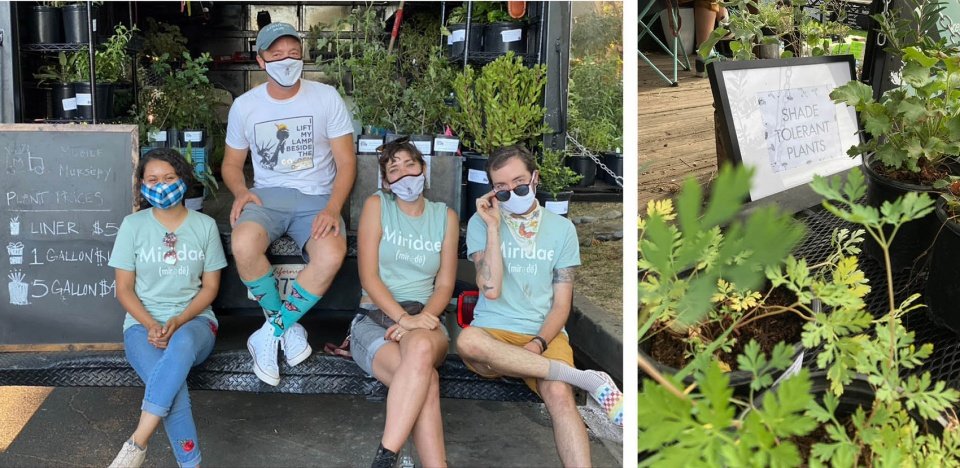
▲教育社区:来自加州大学戴维斯分校景观设计学和生态学的博士生和毕业生参与了移动苗圃的经营,他们为客人提出具有针对性的建议和提示,以帮助他们有效地将本地植物种植在自己的花园。Educating Communities. UC Davis landscape architecture and PhD ecology students and graduates run the Mobile Nursery and provide visitors with custom, location-specific advice and tips to effectively incorporate native plants into their gardens.© Miridae
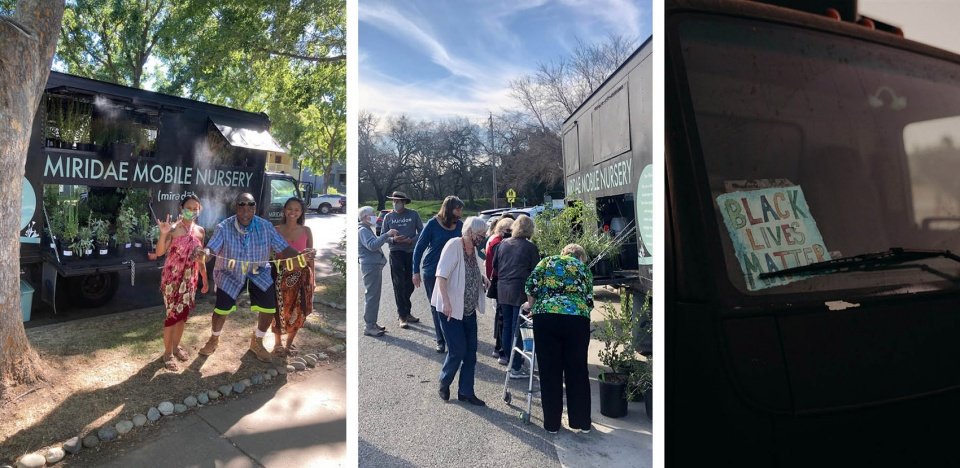
▲建造社区:根据多个主持人的反馈,移动苗圃以一种全新的方法将他们与社区联系在一起——人们认识了之前从未见过的邻居,发现了彼此不知道的共同点,并通过销售植物的机会让大家以安全的方式聚集在一起。Building Community. Hosts have shared that the Mobile Nursery connected them to their communities in new ways – meeting new neighbors, discovering common ground, and using plant sales as opportunities to come together when other options, like church, were not safe.©Miridae; Oak + Oval Photography
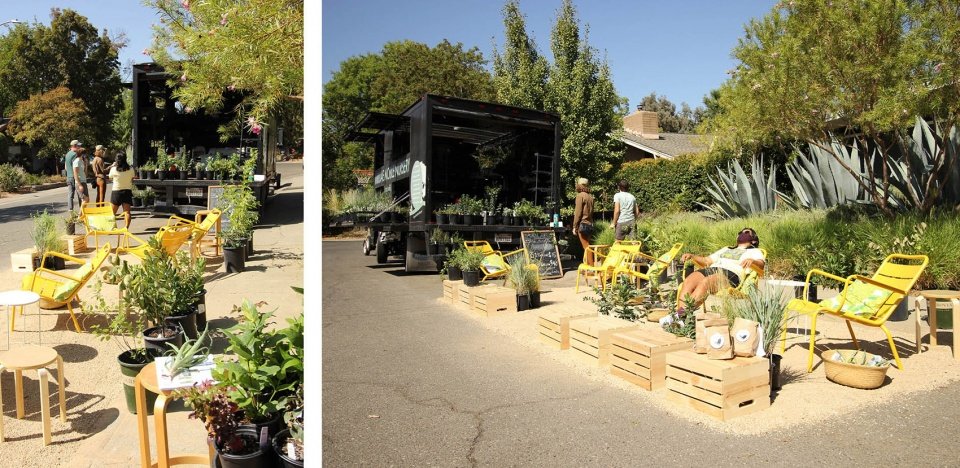
▲公园日:在今年的ASLA公园日,移动苗圃出现在加州戴维斯的某社区。居民们从繁忙的工作中抽出时间来享受日光浴,并为他们自己种植的花园采购植物。PARK(ing) Day. The Mobile Nursery popped up for this year’s ASLA PARK(ing) Day in a neighborhood in Davis, California. Neighbors took breaks from their busy work days to enjoy the sun and purchase plants for their growing gardens.©Miridae
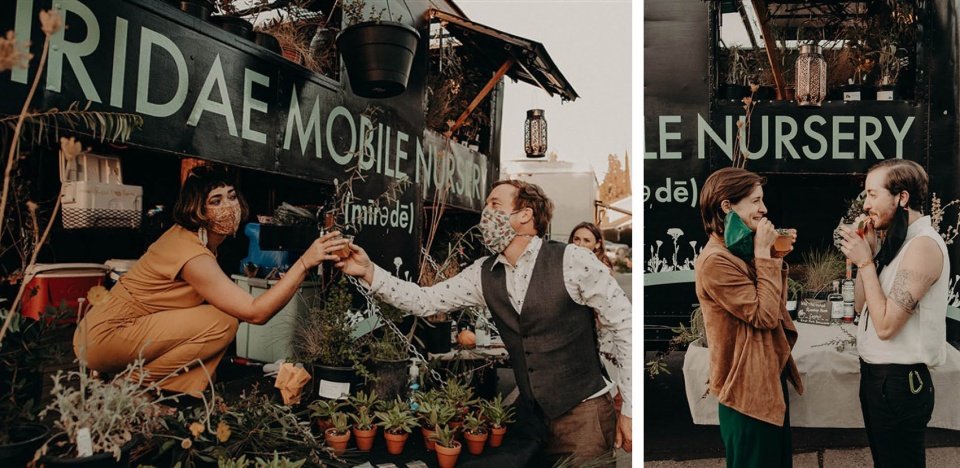
▲社会和教育意义:移动苗圃还支持其他各种特殊的活动,例如婚礼、啤酒节、公寓开幕式等,为平常的社交活动赋予额外的教育意义。Social and Educational. The Mobile Nursery has supported other special events such as weddings, beer festivals, and apartment building openings, providing an educational narrative to the otherwise social engagements.© Oak + Oval Photography
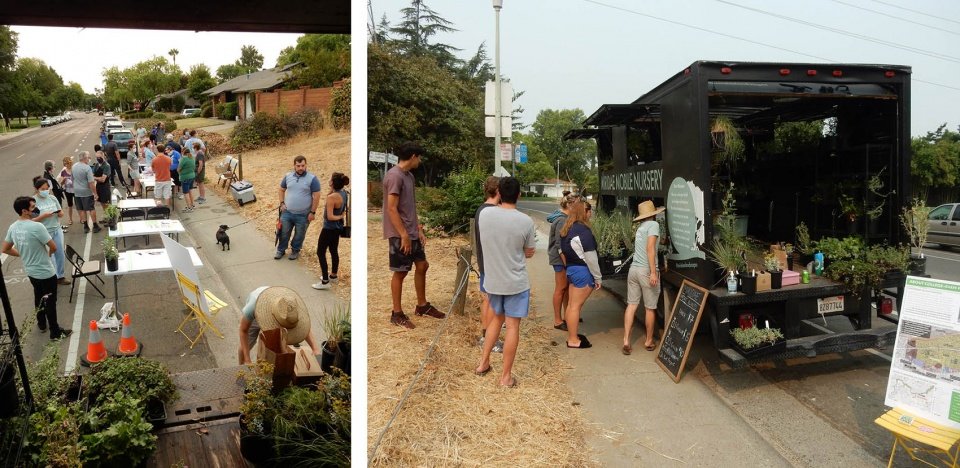
▲社区参与:移动苗圃也被尝试用于社区参与和设计活动。它就像是磁铁一般,吸引着人们来到活动现场,并向其科普在更大尺度的设计项目中选用加州本土植物的重要性。Community Engagement. The Mobile Nursery is activated for community engagement and design events. It acts as a magnet, drawing people to the event and educating them about the importance of California native plants in the context of larger-scale design projects.©Miridae
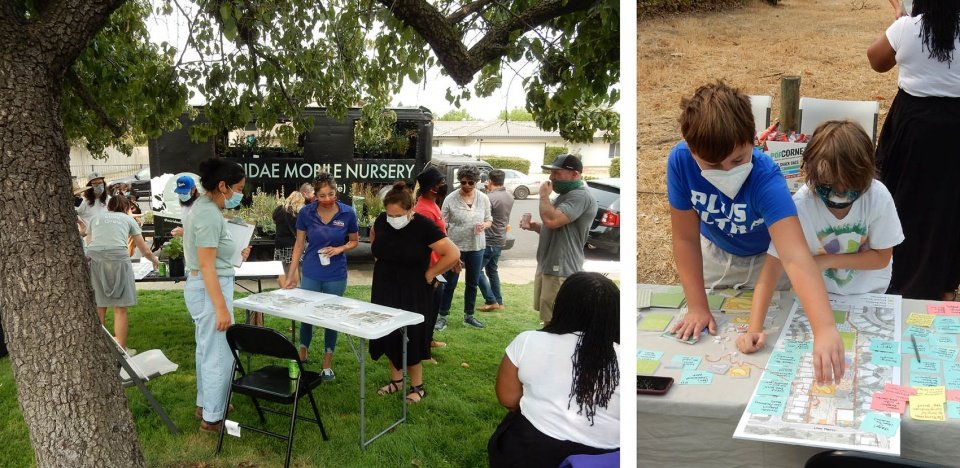
▲社区参与:移动苗圃通过参与、教育和展示,为设计过程创造社区支持。Community Engagement. The Mobile Nursery creates community buy-in for a design process through engagement, education, and exposure.©Miridae
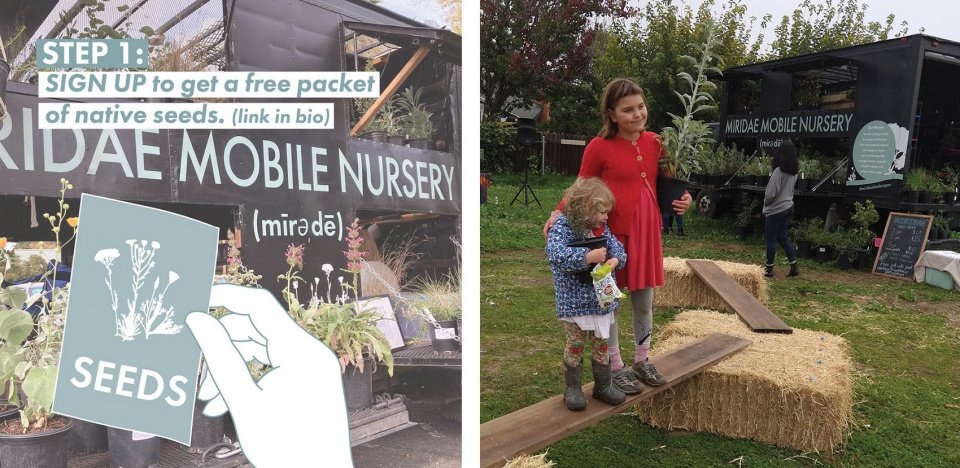
▲创造公民科学家:移动苗圃创造了一批新的公民科学家,他们为一系列研究问题提供信息并收集数据。景观设计团队与非营利组织将积极处理这些问题并将它们纳入具体的建设工作。Creating Citizen Scientists. The Mobile Nursery has created a new set of citizen scientists who inform and gather data for a series of research questions that our design team and non-profit are taking on and incorporating into our built work.©Miridae
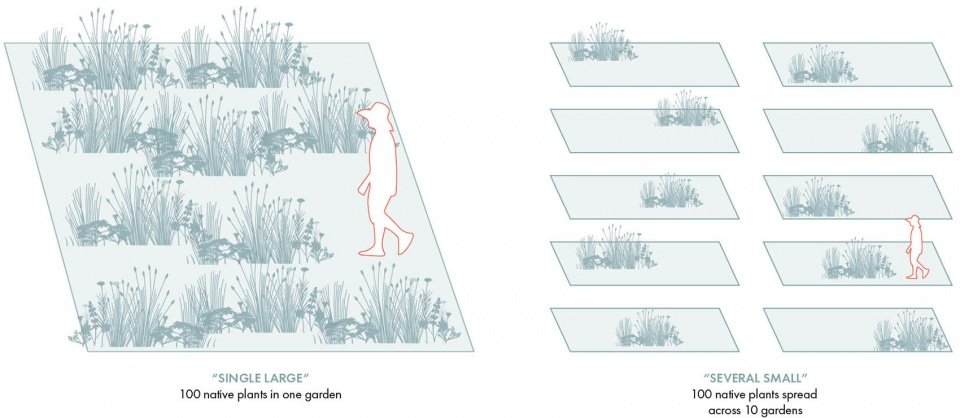
▲提出研究问题:移动苗圃的基本设计和运作支持SLOSS讨论中“小而多”的观点。项目团队正在积极研究SLOSS理论如何在较小的花园尺度中发挥作用。Asking Research Questions. The fundamental design and operations of the Mobile Nursery support the “several small” side of the SLOSS (Single Large or Several Small) research debate. We are actively researching how SLOSS plays out at this smaller garden scale.©Miridae
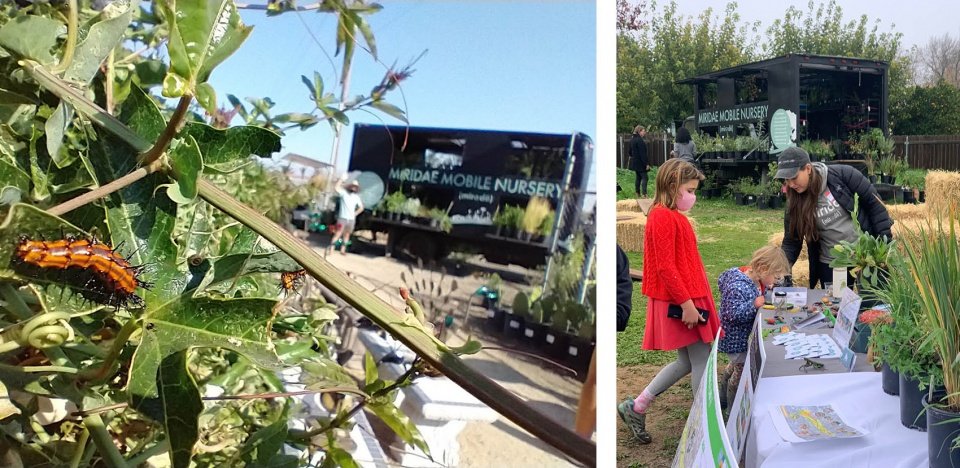
▲带领研讨会:非盈利组织与移动苗圃建立了合作,将举办一系列专注于STEM教学的研讨会,旨在向人们阐释,我们的城市和郊区如何为缓解气候变化以及建立重要的鸟类、授粉者和昆虫栖息地提供重要的机会。Leading Workshops. Our non-profit works with the Mobile Nursery to offer workshops that focus on STEM education, teaching how our urban and suburban areas are powerful opportunities to mitigate climate change and to build critical bird, pollinator, and insect habitat.©Miridae
PROJECT NARRATIVE
THE DESIGN: FROM TRUCK TO NURSERY
The Mobile Nursery was created to foster native landscapes at the scale of the neighborhood, to make these plants more accessible to a diverse set of people, and to communicate the importance of building this patchwork of habitat across our neighborhoods. The company’s established design and build business had long strived to support do-it-yourself gardeners and people with budgets too small for typical yard overhauls. We had long recognized them as important agents of change for our built environment. How could we help them successfully plant native plants that support wildlife local to the Sacramento area? How could we organize multiple neighbors to work together to create habitats comprising the sum of their individual gardens, even without large budgets? And how could we turn gardeners into citizen scientists, empowering them to help create data-informed best practices that could shape the future of the sustainable landscaping industry? This neighborhood scale gardening has been a crucial missing piece in the puzzle to designing wildlife habitat into human-dominated spaces.
Enter the Mobile Nursery, which was purchased in February 2020 as a graffiti-covered produce delivery box truck. We wanted the truck to be functional and interactive, and to fold out into a retail space, with tables to sell plants on, overhangs for shade, and misters for Sacramento’s hot summers. To keep the plants thriving, we needed air, sun, water, and solar energy to run the truck’s nursery operations. Working with our design and build teams, we iterated layouts for the truck’s modifications. The final design is simple and functional, with two fold-out tables and two overhangs on each side of the truck. The tables leave room for people to walk between the plants for sale and the overhangs provide shade and act as windows to showcase additional plants in the truck. Last, we added a plant and insect-inspired “jingle” – similar to that of an ice cream truck – to alert neighbors to the plant sales. The jingle is composed of natural sounds from local native wildlife, like tree crickets, gold finches, lupine seeds popping, and even monarch caterpillars chewing.
BUILDING COMMUNITY WITH NATIVE PLANTS
The Mobile Nursery officially launched in May 2020 when the world was stuck at home in quarantine, filled with anxiety around the global Covid-19 pandemic. Many people were eager to get outside, to plant and garden, but they were wary of going to big box stores. It was the right time for gardening to bring people together in their own neighborhoods, and we developed a method for the Mobile Nursery to run effectively, efficiently, and safely.
To make this a sustainable endeavor, we hired a handful of UC Davis landscape architecture and PhD ecology students and we created a Host Toolkit for residents to recruit neighbors and promote the Mobile Nursery visits. There is no fee or obligation for a minimum amount of people; goodwill and best efforts are enough. The Host Toolkit includes email, social media, and flier templates, making the promotional piece easy and effective for the neighborhood host. We have heard from multiple hosts that hosting the Mobile Nursery connected them to their communities in new ways – folks met neighbors they had never met, discovered common ground they didn’t know was there, and used plant sales as opportunities to come together safely when other options, like church, were not safe.
As the pandemic continued, we began working with restaurants and breweries to cross-promote and encourage outdoor engagement with people. We have a number of regular restaurant and brewery hosts in the Sacramento region in addition to individuals, community gardens and farmers’ markets in neighborhoods. We have been able to support some of these businesses by designating them as pick-up zones for pre-ordered plants, which draws people to pick up their plants and grab a bite or beer while there. Even though the mask and social-distancing mandates have been lifted in California, these relationships have continued.
The Mobile Nursery is booked nearly every weekend, from neighborhoods in Sacramento’s urban grid to wealthy and working class suburban areas comprising a diversity of neighborhoods, demographics, and ethnic/political orientations. People want to have safe access to plants, and many strived to bring their neighborhoods together as much as they wanted to buy plants. We have met wonderful people, many of whom are leaders in their communities.
The Mobile Nursery is also activated for more formal community engagement and design events. It acts as a magnet, drawing people to the event, and as an educational tool, explaining why certain design elements – such as California native grasslands, hedgerows, and pollinator gardens – are integral elements of the proposed design. It creates community buy-in through engagement, education, and exposure to native plants.
The students who run the Mobile Nursery are motivated about spreading the word about native plants and facilitating their use throughout the region. Since we sell plants to people in their own neighborhoods, we can provide advice on what plants to plant where, as well as tips on watering and what wildlife to watch for, custom-tailored to each location. We spread the good word on native plants to residents that previously hadn’t even considered their benefits.
NEXT STEPS: CREATING CITIZEN SCIENTISTS + RESEARCH
The Mobile Nursery has created a new set of citizen scientists and inspired a series of research questions which our landscape architecture and construction team, paired with our non-profit, are actively taking on and designing into our built work. For example, if the plants we sell set seed, do the seeds germinate within the urban/suburban environment? Where do the seeds go? And how far? These questions have led to an on-going project called, The Seed Pile Project, where we ask participants (i.e., citizen scientists) to place piles of native seeds along sidewalks in cities, suburban areas, and roadsides, map them using GPS, then monitor the locations for germination and growth of the plant. The goal is to observe, track, and collect data on which, if any, species successfully drop seed on their own, and under what environmental and management circumstances. It is a citizen science project that germinated from the Mobile Nursery, its daily operations, and conversations with neighbors. Hopefully its results will inform designers which species to plant near sidewalks and advise city planners on which species to specify along roadways and bike paths.
The Mobile Nursery has also asked us to look closer at the impact of the neighborhood scale: how does selling a few native plants to an individual compare with planting hundreds in a larger project? In other words, is 100 plants in one garden better or worse ecologically compared with 10 plants in 10 gardens? We are turning a classic research debate on SLOSS (Single Large or Several Small), a concept in ecological restoration, on its head by looking at the theory at this smaller neighborhood scale. The SLOSS debate has classically been applied to large spaces like marine reserves when considering how to optimize resource investment for conservation, rather than the small ones that our Mobile Nursery addresses, like urban gardens and neighborhoods.
The Mobile Nursery has a simple mission and business model. Its mission is to get native plants into neighborhoods and to engage people with them. Its business model is that it has to be fun and it must cover its own bills. Any profits are directed towards our company’s non-profit, which uses native insects and plants as tools for workshops and makes STEM education more accessible. The Mobile Nursery is constantly evolving and growing into research and design projects, most of which focus on this oftentimes overlooked everyday residential realm and neighborhood scale.
More:ASLA;Miridae
